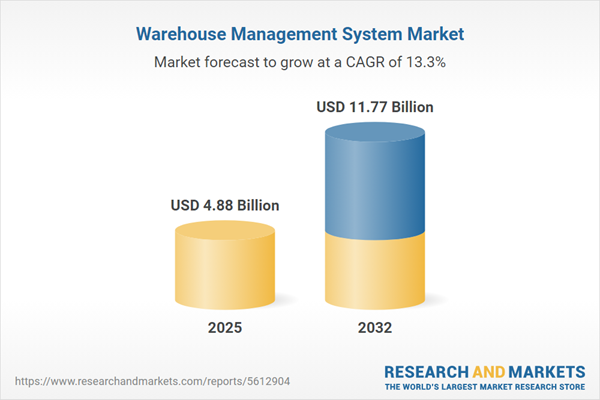Speak directly to the analyst to clarify any post sales queries you may have.
The warehouse management system market is rapidly transforming as organizations prioritize operational agility, integrating advanced software and automation to navigate a shifting global landscape. Senior executives require clear, forward-looking insights to optimize supply chain performance, safeguard margins, and deliver sustained value through technological adoption.
Market Snapshot: Warehouse Management System Market Overview
The Warehouse Management System Market grew from USD 4.33 billion in 2024 to USD 4.88 billion in 2025. It is expected to continue expanding at a CAGR of 13.31%, ultimately reaching USD 11.77 billion by 2032. This growth is fueled by rising consumer demand for efficient fulfillment, complex supply chain dynamics, and accelerated digital transformation across logistics networks.
Scope & Segmentation: Strategic Depth and Breadth
- Components: Hardware (automation equipment, scanning devices, storage solutions); Software (data analytics, real-time tracking, resource optimization)
- Functionality: Analytics & optimization, billing & yard management, consulting services, labor management, systems integration & maintenance
- Deployment Type: Cloud, on-premises
- Application: Food & beverage, healthcare, manufacturing, retail, transportation & logistics
- End-User: In-house logistics departments, third-party logistics providers
- Regions: Americas (North America: United States, Canada, Mexico; Latin America: Brazil, Argentina, Chile, Colombia, Peru); Europe, Middle East & Africa (Europe: United Kingdom, Germany, France, Russia, Italy, Spain, Netherlands, Sweden, Poland, Switzerland; Middle East: United Arab Emirates, Saudi Arabia, Qatar, Turkey, Israel; Africa: South Africa, Nigeria, Egypt, Kenya); Asia-Pacific (China, India, Japan, Australia, South Korea, Indonesia, Thailand, Malaysia, Singapore, Taiwan)
- Key Companies: ABB Ltd., Alba Smart Automation Pvt Ltd, AvanSaber Inc & AvanSaber Technologies Pvt Ltd., Blue Yonder Group, Inc., BluJay Solutions by e2open, LLC, Brightpearl, Inc., Cantaloupe, Inc., Datapel Systems Pty Ltd., Dematic Group, Epicor Software Corporation, Extensiv, Fulfilld.io, Generix Group, Honeywell International Inc., Infor, International Business Machines Corporation, Korber AG, Logiwa, Inc., Made4net, Manhattan Associates, Inc., Oracle Corporation, proLogistik Group, PSI Logistics GmbH, Reply S.p.A., SAP SE, Schneider Electric SE, Softeon, Synergy Logistics Ltd., Tecsys Inc., Viastore SYSTEMS GmbH
Key Takeaways for Decision-Makers
- The market is evolving as organizations converge robotics, intelligent analytics, and cloud-based platforms to achieve higher operational efficiency and adaptability.
- Modular and scalable systems are increasingly essential for rapid deployment and seamless technology integration, enabling firms to respond quickly to new business requirements.
- Integrated software and hardware ecosystems are replacing legacy processes, offering real-time tracking, predictive analytics, and resource optimization that support complex, multi-site operations.
- Strategic collaboration with consulting and integration specialists accelerates time to value and supports digital transformation initiatives.
- Regional market shifts are influenced by regulatory harmonization, infrastructure investments, and e-commerce expansion, shaping WMS modernization priorities globally.
- Specialized innovators and agile entrants are challenging traditional players by focusing on niche capabilities such as yard management and advanced slotting, driving competition on service, scalability, and interoperability.
Tariff Impact: Managing Margin Risk in Global Supply Chains
Ongoing adjustments to international tariffs, particularly in the United States for 2025, are compelling companies to reevaluate sourcing and procurement strategies to mitigate increased cost pressures. Many are diversifying supplier networks, relocating production closer to demand centers, or adopting tariff engineering approaches to manage duty impact. Advanced warehouse management systems now play a pivotal role in supporting these strategies by delivering real-time visibility and enabling agile inventory placement, helping organizations minimize exposure and maintain service outcomes amid regulatory change.
Methodology & Data Sources
This analysis draws upon a rigorous mix of secondary research and primary validation. Sources include industry publications, regulatory filings, and customs data for landscape mapping, supplemented by executive interviews, facility observations, and cross-comparisons of vendor disclosures and client feedback. This approach produces evidence-based insights relevant to practical decision-making.
Why This Report Matters: Actionable Insights for Senior Leaders
- Enable informed, future-ready warehouse management system investment strategies aligned with evolving operational, regulatory, and customer needs.
- Equip organizations to anticipate and mitigate disruption by leveraging emerging technologies and regional dynamics for sustainable excellence.
Conclusion
The evolution of warehouse management systems is creating new pathways to agility and resilience. Leaders equipped with strategic, evidence-based insights can position their operations as engines of value and sustained growth in an increasingly complex supply chain environment.
Additional Product Information:
- Purchase of this report includes 1 year online access with quarterly updates.
- This report can be updated on request. Please contact our Customer Experience team using the Ask a Question widget on our website.
Table of Contents
3. Executive Summary
4. Market Overview
7. Cumulative Impact of Artificial Intelligence 2025
Companies Mentioned
The companies profiled in this Warehouse Management System market report include:- ABB Ltd.
- Alba Smart Automation Pvt Ltd
- AvanSaber Inc & AvanSaber Technologies Pvt Ltd.
- Blue Yonder Group, Inc.
- BluJay Solutions by e2open, LLC
- Brightpearl, Inc.
- Cantaloupe, Inc.
- Datapel Systems Pty Ltd.
- Dematic Group
- Epicor Software Corporation
- Extensiv
- Fulfilld.io
- Generix Group
- Honeywell International Inc.
- Infor
- International Business Machines Corporation
- Korber AG
- Logiwa, Inc.
- Made4net
- Manhattan Associates, Inc.
- Oracle Corporation
- proLogistik Group
- PSI Logistics GmbH
- Reply S.p.A.
- SAP SE
- Schneider Electric SE
- Softeon
- Synergy Logistics Ltd.
- Tecsys Inc.
- Viastore SYSTEMS GmbH
Table Information
| Report Attribute | Details |
|---|---|
| No. of Pages | 198 |
| Published | November 2025 |
| Forecast Period | 2025 - 2032 |
| Estimated Market Value ( USD | $ 4.88 Billion |
| Forecasted Market Value ( USD | $ 11.77 Billion |
| Compound Annual Growth Rate | 13.3% |
| Regions Covered | Global |
| No. of Companies Mentioned | 31 |









